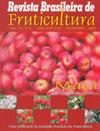Description of the peach fruit growth curve by diphasic sigmoidal nonlinear models
IF 0.9
4区 农林科学
Q4 HORTICULTURE
引用次数: 6
Abstract
Abstract The aim of this study was to describe the growth curve of “Aurora 1” peaches using fruit height and diameter data over time through diphasic sigmoidal models constructed from eight combinations of the following models: Brody, Gompertz and Logistic. Data were obtained from an experiment carried out in 2005 in the municipality of Vista Alegre do Alto, São Paulo, Brazil. The parameters of models were adjusted by the least squares method using the Gauss-Newton algorithm implemented in the R software. Assumptions of normality, homogeneity and independence of residues were verified based on Shapiro-Wilk, Breush and Pagan and Durbin-Watson tests, respectively. The goodness of fit of models was verified according to the corrected Akaike information criterion (AICc), residual standard deviation (RSD), asymptote adjustment index (AI) and nonlinearity measures. All models adjusted for both fruit height and diameter variables met the assumptions of normality, independence and homoscedasticity of errors. In addition, all of them present good quality of fit to fruit height and diameter data, since they presented AI values close to one and low RSD values and non-linearity measures. However, the double Gompertz (GG) and the Logistic + Gompertz (LG) models presented, respectively, the best quality of fit to fruit height and diameter data in relation to the other models. It could be concluded that all diphasic sigmoidal models evaluated showed good fit to height and diameter data and can be used to describe the growth curve of “Aurora-1” peaches, according to goodness of fit criteria. However, it is important to highlight that GG and LG models presented the best quality of fit and can be selected to describe the height and diameter growth of “Aurora 1” peach fruits, respectively, with maximum expected growth close to 63 mm in height and 48 mm in diameter.桃果实生长曲线的双相位s型非线性模型描述
摘要以“极光1号”桃为研究对象,利用果实高度和直径随时间的变化规律,采用Brody、Gompertz和Logistic模型组合构建双相s型模型。数据来自2005年在巴西圣保罗市Vista Alegre do Alto市进行的一项实验。利用R软件实现的高斯-牛顿算法,采用最小二乘法对模型参数进行调整。基于Shapiro-Wilk检验、Breush检验、Pagan检验和Durbin-Watson检验分别验证残差的正态性假设、同质性假设和独立性假设。通过校正后的赤池信息准则(AICc)、残差标准差(RSD)、渐近线平差指数(AI)和非线性测度验证模型的拟合优度。对果高和果径变量进行调整的所有模型均符合误差的正态性、独立性和均方差假设。此外,它们对果实高度和直径数据的拟合质量都很好,因为它们的AI值接近于1,RSD值很低,并且具有非线性测量。然而,双Gompertz (GG)和Logistic + Gompertz (LG)模型对果实高度和直径数据的拟合质量最好。结果表明,所评价的双相s型模型与桃高、桃径数据拟合良好,符合拟合优度标准,可用于描述“极光1号”桃的生长曲线。然而,需要强调的是,GG和LG模型的拟合质量最好,可以分别用来描述“极光1号”果实的高度和直径生长,最大期望生长接近63 mm高和48 mm直径。
本文章由计算机程序翻译,如有差异,请以英文原文为准。
求助全文
约1分钟内获得全文
求助全文
来源期刊
CiteScore
1.50
自引率
20.00%
发文量
34
审稿时长
4-8 weeks
期刊介绍:
The Revista Brasileira de Fruticultura (RBF) publishes technical articles and scientific communications in the area of fruit crops, referring to results of original searches and unpublished papers in Portuguese, Spanish or English, and 1 or 2 reviews per edition, of invited authors.

 求助内容:
求助内容: 应助结果提醒方式:
应助结果提醒方式:


